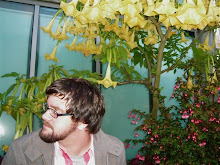Last night I turned on the television to see if it would lull me to sleep. I flipped the channels and stopped, by default, on the Bravo network. The show that was on was a re-airing of
Work of Art: The Next Great Artist.
For those unfamiliar with the show,
Work of Art casts a dozen or so artists - mostly of the "emerging" set, it seems - in a series of art making contests, with the winner to be crowned the next great artist, whatever that might mean. Essentially, it's an art version of the network's other highly popular series', such as
Top Chef and
Project Runway. As the show airs week-to-week, the contestants live together in a posh loft and compete with each other to make art within a distinct set of criteria. They're judged and artists are eliminated one-by-one. Last night's episode required contestants to use discarded and antiquated technology to create a sculpture.
Initially, I scoffed at the idea of this show. TV + art + fabricated contests seemed preposterous and contrary to what art is supposed to be about. Actually, it made me feel very uncomfortable. I thought, How could artists who respect themselves, their work and creative process succumb to the temptation to give themselves over to a contest? Forget the potentially lucrative commercial effect an appearance on such a show could produce. The whole idea smacks of insincerity.
At the conclusion of what I saw - admittedly I missed the very beginning of the episode - I realized it was more than my initial reaction that made me feel uncomfortable. My contempt moved (mostly) away from a critique of the artists' collective and individual motivations for participating and their graduate student sense of general self-importance. Instead, I realized the unidentifiable quality that made me feel so agitated about the whole thing was the separation between the events of the show and the audience seeming to experience the events of the show. More pointedly, it's the way the audience is left to observe the critique of the artists' works, as if our participation as viewers makes us intimate insiders in the conversation that takes place around the judges table.
In the show, several respected members of the art world (seasoned critic with English accent, middle-aged New York gallery owner, established found object sculptor, and so on) as well as the contestants themselves, (whose comments seemed to be selectively included for dramatic effect, btw) pass judgement on the contestants worthiness to be called the next-great-artist. The composition, presentation and attitude of the judges comes off as 1 part informed, canonical criticism, and 2 parts gossipy vamping for the cameras. Its what we're supposed to think the art world is all about, particularly the New York art world, the supposed epicenter of all things art.
But this is the real problem of the show. Like its
Runway and
Top Chef compatriots (and most "reality TV")
Work of Art disguises realism with melodrama. Viewers see glimpses of the artists' work and process, but its patronizing. Just as we're left to experience how tasty as chef's meal must be through the soft-core noshing of a set of expert judges, we're told what to think about each artists work. This effectively - and purposely - cuts off any opportunity to participate in a meaningful dialogue about art, much less actually think about it for ourselves. We are teased with bits of conflict among the artists. A tender and damaged contestant with OCD laments about how "distractingly boring" another artist's orderly and minimal(!) work is. One of the judges brazenly likens an installation to a window display. Collective agreement is reached, verdicts are read off and we're told what is successful without actually experiencing anything for ourselves. But we've seen all the footage, so they must be right, right?
I can't help thinking, Is the seriousness of the contestants/judges sincere? Does the show itself become some sort of conceptual work? Have the participants transcended their purported artistic roles and become subjects in another work entirely? Is the whole thing just cleverness and drama disguised as art? These are the kinds of questions that could make this sort of show interesting, but are nowhere to be found. Perhaps they're implied, or maybe they don't matter. Either way, I get the feeling the producers don't care. After all, it's hard to take seriously a show that's incessantly peppered with promo spots for a series of shows about over-ripe bimbos that represent "real housewives".
For those interested in participating in a real dialogue about and with art, there are several good places to start. One is the monthly
art quiz at the Bemis Underground. It's the brainchild of artist Wanda Ewing and BU curator Brigitte McQueen. For a more personal, educational experience, head upstairs to a
First Thursday Art Talk, featuring the ever-changing flow of Bemis Center residents and guest artists. And sure, there are plenty of other opportunities outside the Bemis Center too.
Unlike
Work of Art, these kinds of real activities allow you to participate and observe from the inside of the fishbowl. You can draw your own conclusions and experiences, English accent or not.
- Peter -
 A few weeks ago I received an email from my clients Patrick and Amy, who were referred to me by their friend... Patrick, a former client and fellow record collector.
A few weeks ago I received an email from my clients Patrick and Amy, who were referred to me by their friend... Patrick, a former client and fellow record collector.

























































